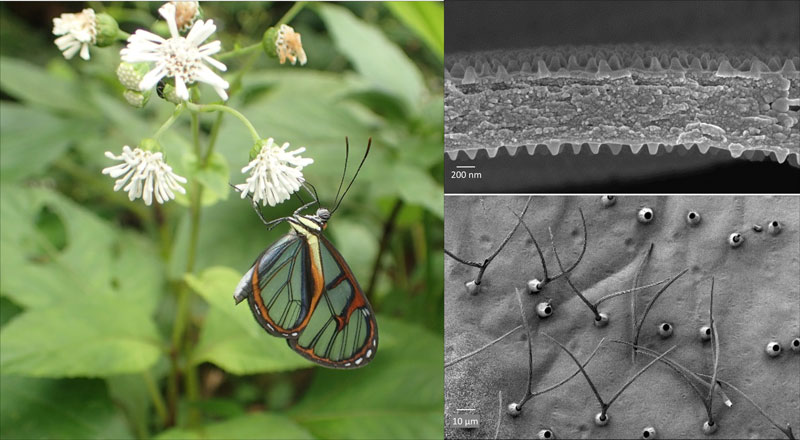Butterflies and moths form the order Lepidoptera, a name derived from the scales (lepis in ancient greek) that cover their large wings (pteron). The scales allow the generation of color patterns, which are involved in mate choice, temperature regulation and anti-predator defenses such as camouflage. Color patterns can also be associated with the presence of toxins, and recognized as such by predators. Such warning color patterns are called aposematic patterns. Aposematic patterns are usually brightly colored and contrasted, which makes them easier to learn by predators. Intriguingly, in the Amazon and the Andes, the wings of many aposematic, distasteful species are partially transparent– a feature typically associated with crypsis.

Figure: The clearwing butterfly species Ithomia diasia (left) is distasteful. Wing transparency is primarily generated by the reduction of scales’ width (bottom right: forked hair-looking scales), and is further enhanced by the presence of nanoprotuberances on the wing membrane (top right). Photo credits: Marianne Elias (butterfly photo), Stephan Borensztajn (microscopy images).
Puzzled by those clearwing aposematic butterflies and moths, we formed an international, interdisciplinary team comprised of evolutionary and developmental biologists and optical physicists. The HFSP research grant allowed us to join forces and combine our expertise to unravel the evolutionary and structural drivers of transparency in these species.
In a first set of studies [1,2] based on predation experiments with wild birds (the main predators), complemented with modeling of bird perception of clearwing and opaque species, we showed that transparency reduces the detectability of butterflies and moths by predators. We also confirmed that clearwing species are distasteful to birds. This led us to conclude that clearwing species are both cryptic and aposematic.
In this new study, we further explore the interplay between crypsis and aposematism. In opaque aposematic butterflies and moths, coexisting species often converge in their wing color patterns, a phenomenon called mimicry. Mimicry is due to the selection imposed by predators: if all species harbor the same wing pattern, predators kill fewer individuals per species during the learning process. In clearwing aposematic butterflies and moths, while the general wing pattern and colored elements converge among species engaging in mimicry, we wondered to what extent the transparent parts of the wings of those species look similar in the eyes of predators. Indeed, there are multiple ways to be transparent: wings can let a large fraction of light pass through them, or only a tiny fraction; they can allow some wavelengths to pass through more than others. We captured variations in transparency among 62 clearwing aposematic species belonging to seven families of butterflies and moths and 10 mimicry ‘rings’ (i. e., sets of species sharing similar aposematic wing pattern) by measuring the spectra of light transmitted through the transparent wing areas. We then used those spectra to model the perception of wings by birds. We found that transparent wing areas of species engaging in mimicry often look more similar to birds than expected under neutral evolution, indicating that predation-related selection for convergence also applies to these areas. Therefore, in clearwing mimetic species mimicry not only entails having transparent patches in the same position of the wing, but also being transparent in the same way.
We then wondered how transparency was generated in those species. We imaged micro and nanostructures of transparent wing areas using scanning electron and digital microscopy. We discovered several types of scale modifications, such as reduction in density, size and change in orientation. These modifications all contribute to reducing the coverage of the wing membrane by scales, thereby increasing light transmission through the wing. Most importantly, we uncovered an unsuspected diversity of tiny protuberances on the surface of the wing membrane. In this and a separate study [3] we showed that, when present, nanoprotuberances enhance transparency by considerably reducing the reflection of light at the surface of the membrane.
Transparency is thus generated in multiple ways in different species, and has evolved many times independently in aposematic butterflies and moths as a result of natural selection. We have now a better understanding of the apparent paradox of the existence of clearwing aposematic butterflies, but further challenges remain to be addressed by our HFSP-supported team: since wing scales are instrumental in wing water-proofing and temperature control, how do clearwing species cope with the dramatic reduction of wing coverage by scales?
|
HFSP award information Research Grant - Program (RGP0014/2016): Development, functions, and evolution of transparency in butterflies: an interdisciplinary approach Principal investigator: Marianne Elias, Institute of Systematics and Evolution of Biodiversity, Paris, France |


































